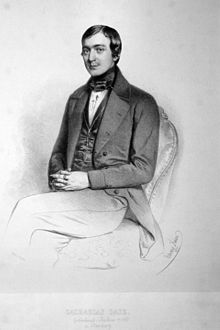Zacharias Dase

Johann Martin Zacharias Dase (born June 23, 1824 in Hamburg ; † September 11, 1861 there ) was a German high-speed calculator and arithmetic artist.
Life
Already in his youth Zacharias Dase showed a passionate love for arithmetic and devoted almost every free hour to the exercise. Since 1839 he appeared in Germany, Austria and England as an arithmetic artist.
In Vienna, for example, he multiplied a 40-digit number by another 40-digit number in 40 minutes, in Wiesbaden a 60-digit number by another 60-digit number in 2 hours and 59 minutes while the company was lively, and in Munich he extracted the square root of a 60-digit number in 20 minutes and one a 100-digit in 52 minutes.
Within two months he calculated the circle number π exactly to 200 places.
In six hours of intensive mental arithmetic, he recognized the repunit number R 11 as a composite number.
Dase was in contact with Carl Friedrich Gauß and Carl Gustav Jacobi .
Fonts
- Dase, Z. [acharias]: The circle circumference for the diameter 1 calculated to 200 decimal places . In: [Crelles] Journal for pure and applied mathematics 27 (1844), No. 3, p. 198. (Göttinger Digitization Center.)
- Blackboard of the natural logarithms of numbers. In shape and size like that of the ordinary or Brigg's logarithms. . Vienna: Summer, 1850.
- Zacharias Dase. Insights and samples of his achievements as an arithmetic artist. Communicated by himself from his album . Berlin: self-published, 1856.
- Factor tables for all numbers of the seventh million, or more precisely from 6000001 to 7002000, with the prime numbers occurring therein . Hamburg: Perthes-Besser & Mauke, 1862.
- Factors tables for all numbers of the eighth million, or more precisely from 7002001 to 8010000, with the prime numbers occurring therein . Hamburg: Perthes-Besser & Mauke, 1863.
- Factor tables for all numbers of the ninth million, or more precisely from 8010001 to 9000000, with the prime numbers occurring therein . Hamburg: Perthes-Besser & Mauke, 1865.
literature
- Moritz Cantor : Dase, Johann Martin Zacharias . In: Allgemeine Deutsche Biographie (ADB). Volume 4, Duncker & Humblot, Leipzig 1876, p. 759.
Web links
- John J. O'Connor, Edmund F. Robertson : Johann Martin Zacharias Dase. In: MacTutor History of Mathematics archive .
- Daguerreotype with a portrait of Dases by Carl Ferdinand Stelzner (around 1845), including a multiplication of two 20-digit numbers. The caption reads: “H [err] Z. [acharias] Dase calculated the other multiplication in my head in 7 minutes, 45 seconds. JE Krüls. "(Original in the Museum for Art and Industry, Hamburg)
Individual evidence
- ↑ Carl Friedrich Gauß writes about this to Christian Ludwig Gerling (Göttingen, January 29, 1847): “The much-mentioned mental calculator Dahse calculated the number π to 200 or more digits and found a result that was roughly the last 40 digits of Rutherford's deviates. Schumacher but Clausen requested to communicate that from him long ago calculated result. This confirms Dahse's calculation, so that one is entitled to consider Rutherford's to be wrong. Clausen's result is calculated on 250 digits, but in such a way that the last two or three are to be regarded as unreliable. Schumacher will soon announce Clausen's numbers in the A [stronomic] news . ”Cf. Clemens Schaefer (ed.): Correspondence between Carl Friedrich Gauß and Christian Ludwig Gerling. Edited on behalf of the Society for the Promotion of All Natural Sciences in Marburg. Berlin 1927, p. 745, no. 362. - Heinrich Christian Schumacher: About the number π, which expresses the ratio of the diameter to the circumference of the circle. In: Astronomische Nachrichten 25 (1847), No. 589, Col. 207-210. - William Rutherford: Computation of the Ratio of the Diameter of a Circle to its circumference to 208 places of figures. In: Philosophical Transactions 131 (1841), pp. 281-283.
| personal data | |
|---|---|
| SURNAME | Dase, Zacharias |
| ALTERNATIVE NAMES | Dase, Johann Martin Zacharias (full name) |
| BRIEF DESCRIPTION | German high-speed calculator and mathematician |
| DATE OF BIRTH | June 23, 1824 |
| PLACE OF BIRTH | Hamburg |
| DATE OF DEATH | September 11, 1861 |
| Place of death | Hamburg |